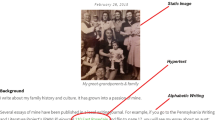Abstract
As university faculty are increasingly called upon to ‘do more with less,’ particularly to teach more students with fewer resources, technology can provide viable solutions to pedagogical dilemmas. Faculty developers are frequently tasked with introducing faculty to or coaching them in the use of technological solutions. With respect to blogs, the typical show-and-tell approach to technology awareness that our faculty development center uses seemed inadequate, given the complexity of blog design, implementation, and maintenance. Instead, we found the best way to instruct university faculty in the use of blogs is to give them an opportunity to participate in a blogging community as part of a Course in College Teaching (CCT). We experimented with two different approaches in two different sections of our CCT. This paper reports on the current blogging culture in higher education, describes our specific context for utilizing blogs, shares implementation decisions and learning affordances, and forwards a set of ‘lessons learned.’





Similar content being viewed by others

Explore related subjects
Discover the latest articles, news and stories from top researchers in related subjects.Notes
Names are pseudonyms.
References
Angelo, T. A., & Cross, K. P. (1993). Classroom assessment techniques: A handbook for college teachers (2nd ed.). San Francisco: Jossey-Bass Publishers.
Betts, J. D., & Glogoff, S. (2004). Instructional models for using weblogs in elearning: A case study from a virtual and hybrid course. Paper presented at the 2004 Syllabus Conference, San Francisco, CA.
Cano, E., M. R. Carbonell, et al. (2012). Developing assessment practices through the use of blogs in higher education: An innovative experience in the open university of Catalonia. Paper presented at the 2012 eLearning and Software for Education Conference, Bucharest.
Cousins, J., & Perris, K. (2009). Supporting faculty at the faculty of medicine: The development of Imperial College of London’s medicine information literacy group. Journal of Information Literacy, 3(1), 60–67.
Downes, S. (2004). Educational Blogging. Educause Review, 39(5), 14–26.
Du, Y. (2006). Modeling the behavior of lurkers in online communities using intentional agents. Paper presented at the International Conference on Computational Intelligence for Modelling Control and Automation, and International Conference on Intelligent Agents, Web Technologies and Internet Commerce, Sydney, Australia.
Glogoff, S. (2005). Instructional blogging: Promoting interactivity, student-centered learning, and peer input. Innovate, 1(5).
Hardy, A., J. Tinney, et al. (2012). Using e-portfolios to support trainee design and technology teachers in developing their subject knowledge. Paper presented at the 26th Annual Pupils’ Attitude Towards Technology (PATT) Conference, Stockholm, Sweden.
Higgins, C. J., Reeves, L., & Byrd, E. (2004). Interactive online journaling: A campus-wide implementation of blogging software. Paper presented at the 32nd annual Association of Computer Machinery Conference on User Services. Baltimore, MD, USA, 2004. ACM Press, 139–142.
Hsu, C. L., & Lin, J. C. C. (2008). Acceptance of blog usage: The roles of technology acceptance, social influence and knowledge sharing motivation. Information & Management, 45(1), 65–74.
Ion, G., & Stingu, M. (2012). Learning pedagogy through blogs: An experience in initial teacher training. Paper presented at the 2012 eLearning and Software for Education Conference, Bucharest.
Kerawalla, L., Minocha, S., Kirkup, G., & Conole, G. (2009). An empirically grounded framework to guide blogging in higher education. Journal of Computer Assisted Learning, 25, 31–42.
Kim, H. N. (2008). The phenomonon of blogs and theoretical model of blog use in educational contexts. Computers & Education, 51, 1342–1352.
Lei, C.U., Krilavicius, T., Zhang, N., Wan, K., & Man, K. L. (2012). Using web 2.0 tools to enhance learning in higher education: A case study in technological education. Paper presented at the International MultiConference of Engineers and Computer Scientists, Hong Kong.
Maag, M. (2005). The potential use of “Blogs” in nursing education. CIN: Computers, Informatics, Nursing, 23, 16–24.
Oravec, J. A. (2003). Blending by blogging: Weblogsin blended learning initiatives. Journal of Educational Media, 28, 225–233.
Rowe, M. (2012). The use of assisted performance within an online social network to develop reflective reasoning in undergraduate physiotherapy students. Medical Teacher, 34(7), 469–475.
Shaffer, S. C., Lackey, S. P., & Bolling, G. W. (2006). Blogging as a venue for nurse faculty development. Nursing Education Perspectives, 27(3), 126–128.
Tompkins, J. (1990). Pedagogy of the distressed. College English, 52(6), 653–660.
Windham, C. (2007). Reflecting, writing and responding: Reasons students blog. Educause Learning Initiative, from http://net.educause.edu/ir/library/pdf/ELI3010.pdf
Author information
Authors and Affiliations
Corresponding author
Rights and permissions
About this article
Cite this article
Ramsay, C.M., Aman, D.D. & Pursel, B.K. Blogging pragmatics and pedagogy: An adventure in faculty development. Educ Inf Technol 19, 425–440 (2014). https://doi.org/10.1007/s10639-012-9221-0
Published:
Issue Date:
DOI: https://doi.org/10.1007/s10639-012-9221-0



